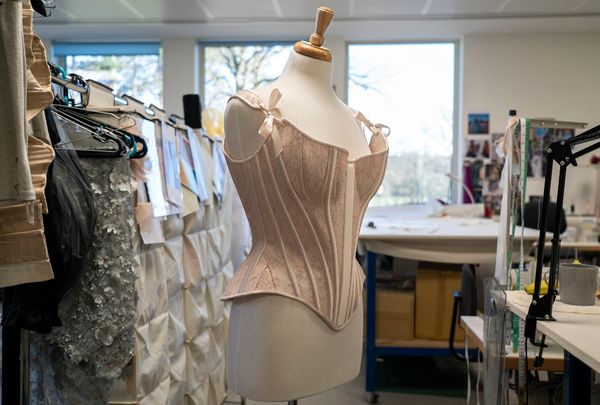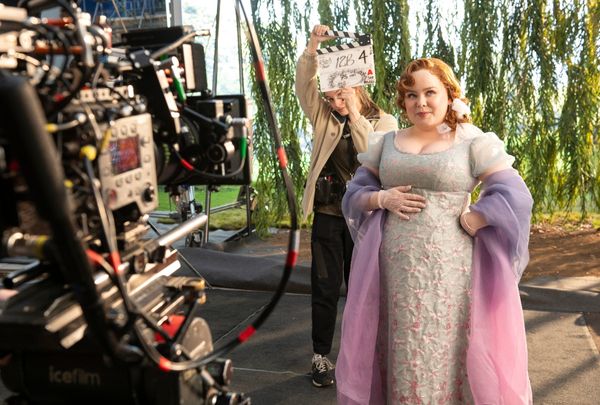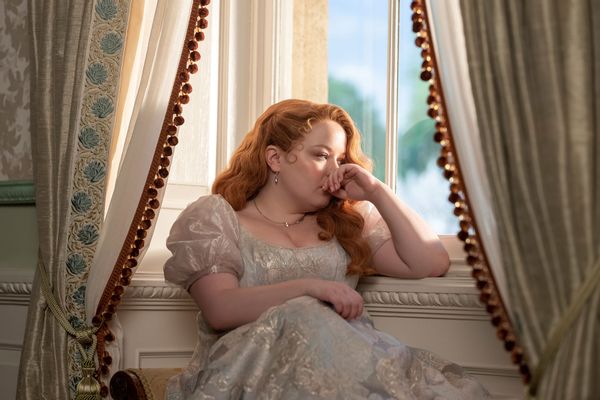
"There are other parts I've been dreaming about."
It's a "Bridgerton" rite of passage for each season's central couple to engage in impassioned and explicit lovemaking. Former wallflower Penelope Featherington (Nicola Coughlan) gets her chance following a long-awaited confession of love by her longtime crush Colin Bridgerton (Luke Newton), in which he enumerates her various charms while they both gaze at her in a full-length mirror.
He pulls a pin to unbind her hair, unfastens her dress and then unlaces her corset, which Penelope holds up on her body – drawing the tension out – before letting it fall dramatically to the ground. She stands proudly naked under his gaze.
Even though the corset is only displayed for a few seconds, that's enough for us to see it in all of its glory. Rose-gold and artfully boned, the corset is simple yet sculpted, with color-matched ribbons as ties. Although undergarments are often hastily set aside in such scenes, this is not meant to be hidden. In fact, the gorgeous garment is featured twice more in the season, as Penelope prepares for her wedding day.
"The envision corset is something that the audience sees, so it's made to be beautiful," costume designer John Glaser tells Salon.
Those devoted to historical accuracy (probably shouldn't be watching "Bridgerton," but we digress) may notice that Penelope's disrobing is far more efficient than one would expect from the usual buttoned-up Regency attire.
"A person at this time would have layers and layers under their clothes for modesty, and this show, we don't do that because we're not historically accurate," acknowledges Glaser. "When we see someone take a dress off, it has to be quick and it has to be clean. It has to be pretty. So we want to get right to the point.
"The dress would be unhooked, and instead of a chemise – which is like what you're wearing [directly underneath] and then a corset – we get right to the corset," he continues. "We want to see the laces down the back so they can undo the laces. And it is very beautiful. It's not always historically accurate, but it's the right shape."

And even though Penelope spends much of that scene unclothed, she has other considerations when it comes to her appearance. She still has to look flawless. This is Jane Austen's Regency era after all, and it would not do for the 'Ton to see this young, unmarried woman with tousled locks or smeared rouge. Even her alter ego, gossip columnist Lady Whistledown, would not let that go unmentioned. Hair and makeup designer Erika Ökvist kept this in mind when deciding on products and styles that would hold up to the actions in that scene.
"Will that get caught in Colin's collar? Is it going to smear her lipstick all over the cheek?" she said. "You then have to choose products and techniques that would work with what they physically have to do as well. So it takes quite a lot of thought process because it has to look good from the beginning until the end. It's a lot of planning, but the most important thing, really is to make the actors feel secure, especially in a scene like that, which is very vulnerable."

The love scene isn't just significant for Penelope and Colin's relationship, but it's also the culmination of Penelope evolving into her own woman, one who eventually squares away Whistledown with her wallflower persona. As a young woman with a brain struggling to establish herself in a society that only sees her as a possible future mother, she needs to find the real-world confidence she displays in her clandestine writing. This begins with seeking to separate herself from her mother's penchant for dressing the Featherington flock in bright citrus hues and torturing their red locks into tightly coiled updos.
Penelope's first attempt at a makeover takes place at one of the early balls of the season, when she makes a grand entrance in a dark emerald gown. While she turns heads with her transformation, the shade comes off as a bit somber and matronly. In this instance, the ensemble doesn't quite work, which is reflected in how Penelope still comes across as fairly awkward. She babbles instead of conversing calmly with possible suitors, and ends up having her dress ripped by resident mean girl Cressida (Jessica Madsen).
"George [Sayer] always says that that situation didn't go so well because the dress is also influenced by the modiste, so it's a dark color that she's never worn," says Glaser. "It's completely different than anything that she has."
Later, Penelope starts to wear more subtle shades in cool hues: seafoam green, robin's egg blue, pale lavenders and mauves, with some blush tones thrown in for good measure.
"She now chose the softer colors because they complement her as an actress," says Glaser. "But it's also good for the character, because it allows the character to still be a wallflower, allows her to travel into the Bridgerton world, the Featherington world and Colin's world. And another reason is since she is in every scene, if we used a strong color palette, you would get tired of it. You really want her story and her character to be the forefront."
A direct result of this palette shift is how it softens the way Penelope's bright red hair appears. Knowing your colors makes a difference.
"The reason why it looks more refined is because in Season 1 she's wearing a lot of yellow, and yellow brings out red," Ökvist explains. "Now she's wearing greens and blues. And what's the opposite of red? It is greens and blues. So it diffuses the red in her color. What you're wearing up against your face really, really matters. And so the costume department really used dresses that were super flattering to her skin tones."

"The most important thing is that Nicola feels secure, happy and supported," says Ökvist. "So we will go with a hairstyle that she would like and love. She really likes having a lot of the hair down. And when an actor feels secure then they can do their best job. So that is number one. Always make the actors feel secure."
That ease is reflected in her attire, which seems to shy away from the boxy, straight silhouette that was popular at the time. Instead, Penelope's figure is shown off with less restrictive necklines, more bouffant sleeves and fuller skirts. Penelope is inspired by fashion trends from Paris, a city that Colin raves about after romancing women from there.
"There's a couple things that work in our favor is that we could move her timeline up to 1820, a little more fashion-forward because of the Paris look, which was a slightly different shape," says Glaser. "We took that historical research and pushed her in the 1950s so that she could have a waist and a shape, a short dress, which is more flattering to her body because she was more mature and sexier and not so young and childlike."
"She looks really soft and feminine at the same time. I think the kids call it 'snatched,'" adds Ökvist. "We needed the round softness, a feminine look, so it wasn't too angular. I think that the old Hollywood look really portrays that."
While Penelope's shape is womanly, her makeup serves to highlight her inexperience and excitement when it comes to young love. "Especially in 'Bridgerton,' we want that kind of flustered, newly kissed look, so we work a lot with blushes," says Ökvist. "Everybody's got maybe two or three different color blushes layered on top of each other."
All of these slight tweaks to her look create an enhanced, empowered version of Penelope, one very different from what the audience has seen in previous seasons. "I think you can see that towards the end, especially the understated elegance, is the one that is almost timeless," Ökvist says. "The icon look, the one where you can't really pinpoint what she was wearing but all you remember is that she looked great. And that's when you wear the look, and the look doesn't wear you, which is a very mature way of being glamorous."
Penelope's appearance parallels her emotional journey. By the end of the season, she takes her fate into her own hands and unmasks herself as Lady Whistledown in front of the Queen and the entire 'Ton. And she's finally accepted for herself.
"Her clothes are now part of her. They're not restricting her. They're part of her. She feels like less is more. It's like her personality, her character, is liberated," says Glaser.
"She takes the front row. She's liberated from decoration and bright colors. It's allowing her to be in the forefront. She's not hiding behind anything. She's now exposed herself — emotionally maybe, she's not hiding behind anything now."







